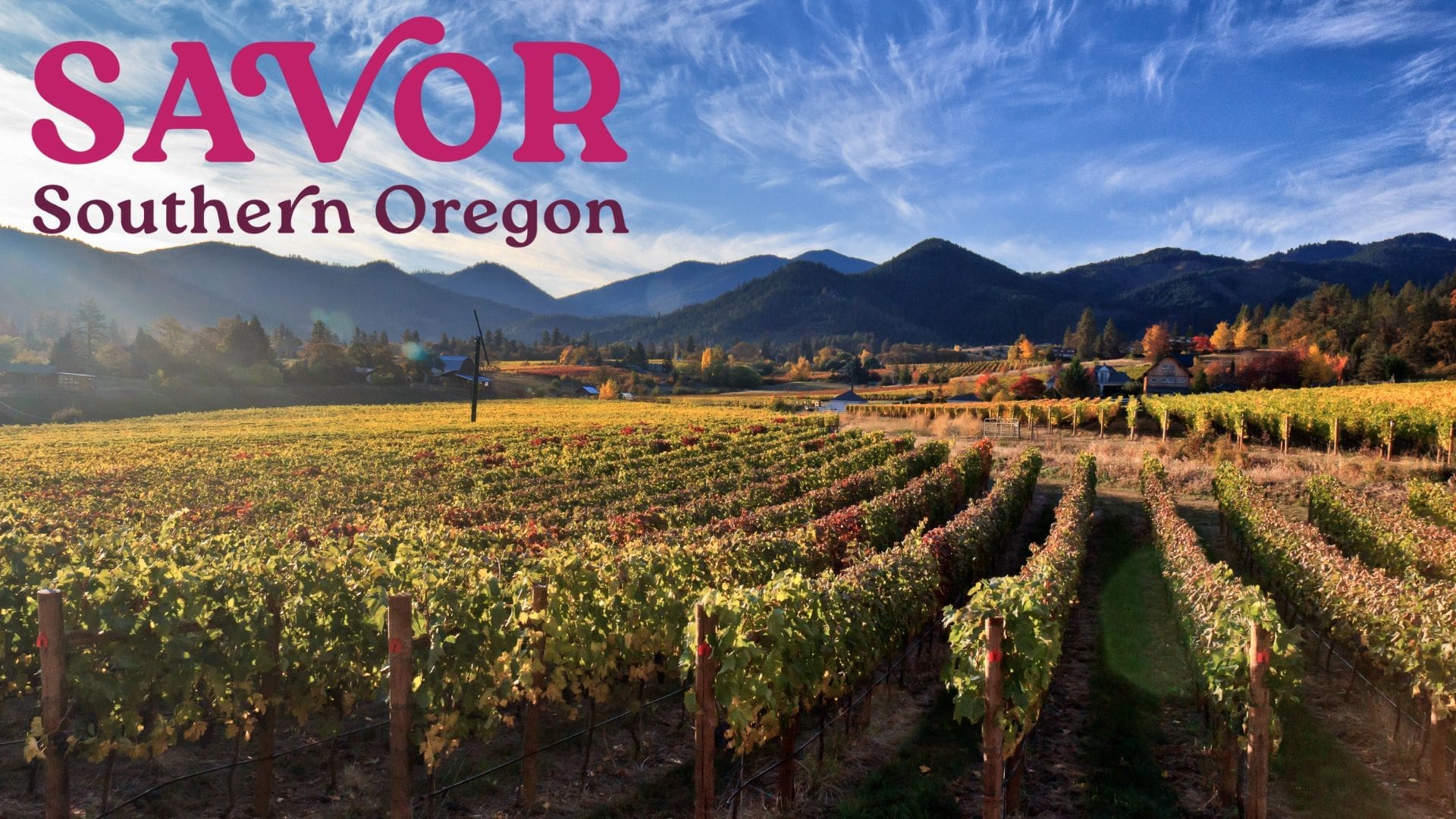The start of Oregon Wine Month is here, and it’s important to understand exactly where your local wines come from within the state. Oregon is compromised of 18 specific winegrowing regions, each distinguishable by geographic location, soil type, climate and topography. These regions are called American Viticultural Areas (AVAs) defined by The Alcohol and Tobacco Tax and Trade Bureau (TTB) and the U.S. Department of the Treasury.
Our beautiful state has a perfectly diverse landscape for growing various grape varietals. Each Oregon AVA is special in it’s own way with wineries dating back to the mid-1800s.
Show off your Oregon wine skills this month with key information about each of Oregon’s 18 AVAs. Facts provided by the Oregon Wine Board.
Contained within the larger Rogue Valley AVA, the Applegate Valley stretches 50 miles north from California’s border to the Rogue River. This southern AVA is home to Oregon’s first official winery, the Valley View Winery founded in 1873. The appellation became official in 2001 with a crucial importance for warm-climate varieties. Applegate typically sees 25.2 inches of annual rain with hot days and cool nights. The soil type is granite in origin with most of the area’s vineyards planted on stream terraces or alluvial fans. Surrounded by the Siskiyou Mountains, vineyards are often grown at elevations up to 2,000 feet.
Located within the Willamette Valley AVA, the Chehalem Mountain area is 20 miles in length and five miles wide. Its winegrowing history dates back to 1968 with official AVA approval in the late fall of 2006. The Chehalem elevation ranges from 200 to 1,633 feet with an annual precipitation rate of 37 to 60 inches. Along with various elevation ranges, the Chehalem Mountains have the greatest temperature variation in the Willamette Valley. The soils are a combination of Columbia River basalt, ocean sedimentation and wind-blown loess derivation. At the tallest point, the Chehalem Mountains are the highest in the Willamette Valley with Bald Peak reaching 1,633 feet above sea level.
This 40-mile region lies in the heart of the Columbia River Gorge, stretching between Oregon and Washington. Grape growing in the Columbia Gorge dates back to the 1880s with some original vines still alive today. The appellation became official in 2004 with climates ranging drastically from cooler climates on the west and high desert further east. Lucky for Columbia Gorge winemakers, a wide range of varietals can be grown within the 40-mile radius. The AVA sits in the narrow river valley with soils compromised of silty loams. Surrounding the sea-level region, Mt. Hood and Mt. Adams are perfectly in view of the vineyards.
Similar to the Columbia Gorge, the Columbia Valley AVA reaches both Oregon and Washington with more than 11 million acres of land in total. The region is 185 miles wide and 200 miles long. Dating back to the 1900s, Columbia Valley is home to 100-year-old Zinfandel vines, which still produce grapes today. The Columbia Valley became an official appellation in 1984; one of the oldest in Oregon AVA history. Around 15,000 years ago, a series of Ice Age floods deposited silt and sand over the area. These sediments make up the area’s present-day soils along with wind-blown loess sediment, all of which are ideal for grape growing. A massive area covering more than 11 million acres, the Columbia Valley stretches through the valleys formed by the Columbia River including Snake, Walla Walla and Yakima rivers.
Yet another sub-AVA located in the Willamette Valley AVA, Dundee Hills rises above the flat floors of the Willamette and Chehalem Valleys. David Lett planted the first Dundee Hills Pinot noir vines in 1965, calling it Eyrie Vineyard. It did not take long after that for winemakers across the state and nation to recognize Dundee Hills as a premier grape-growing region. The appellation was approved in 2005. The Coast Range protects Dundee Hills from the Pacific Ocean’s heavy rain and windstorms, creating warmer nights and less frost than the adjacent AVAs. Dundee Hills is known for rich, red volcanic Jory soil formed by ancient volcanic basalt and consisting of silt, clay and loam soils. The viticultural region is a single, continuous landmass that rises above the surrounding Willamette Valley with its highest peak of 1,067 feet.
Located in Douglas County, Oregon, the Elkton AVA is situated 33 miles east of the Pacific Ocean. The entirety of Elkton sits in the Umpqua Valley AVA, which is part of the great Southern Oregon AVA. Elkton Oregon is the northernmost and lowest elevation of the Umpqua Valley, covering 11 percent of the land. Along with the lowest elevation, Elkton also provides the coolest and wettest climate with an annual rainfall of 50 inches. This in turn provides the greater region with different varieties and wine styles. Dominated by the coastal mountain geology, Elkton lies over a mix of sedimentary, volcanic and metamorphic rock units from the middle Eocene. The National Resource Conservation Service mapped more than 50 different soil series or complexes in Elkton Oregon. A majority of the AVA falls below the 1,000-foot contour with elevation as low as 130 feet.
Located in the Willamette Valley AVA, Eola-Amity Hills is northwest of Salem with agricultural history dating back to the mid-1850s. Although the agricultural history has a historic foundation, winegrowing only began in the 1970s. The appellation became official in 2006 with warm summers, mild winters and 40 inches of annual rainfall providing a climate perfect for growing cool grape varieties. The Eola-Amity Hills soils are composed of volcanic basalt from ancient lava flows, marine sedimentary rocks and alluvial deposits at the lower elevations of the ridge. The majority of the region sits between 250 to 700 feet above sea level.
Also located within the Willamette Valley AVA, McMinnville has a lengthy farming history dating back to the mid-1800s. In 1987, McMinnville held the first ever three-day International Pinot Noir Celebration, which has been happening every July since its first installment. The AVA was established in 2005, sitting in the protective weather shadow of the Coast Range. This provides drier climates and higher elevations, making it resistant to frost. The McMinnville soils are mainly uplifted marine sedimentary loams and silts, with alluvial overlays. These provide shallow, low total available moisture for wine grape growing in the region. The Nestucca Formation — a 2,000-foot-thick bedrock formation — extends west of the city of McMinnville to the slopes of the Coast Range, resulting in unique wine production and flavor profiles.
Around 30 miles north of Roseburg, the Umpqua Valley AVA encompasses Red Hill Douglas County. The region’s first established vineyard was planted in the small town of Yoncalla in 1876. Red Hill Douglas County has a relatively mild climate with marine influences and lower average daytime temperatures during growing season. Due to the higher elevation, Red Hill Douglas County typically has a frost-free growing season. The appellation was approved in 2008. Similar to Dundee Hills, Red Hill Douglas County is dominated by iron-rich, red volcanic Jory soils formed by ancient volcanic basalt. These consist of silt, clay and loam soils and are considered premier grape growing soils. Red Hill is part of the Umpqua Formation with elevations ranging from a minimum of 800 feet to a maximum of 1,200.











